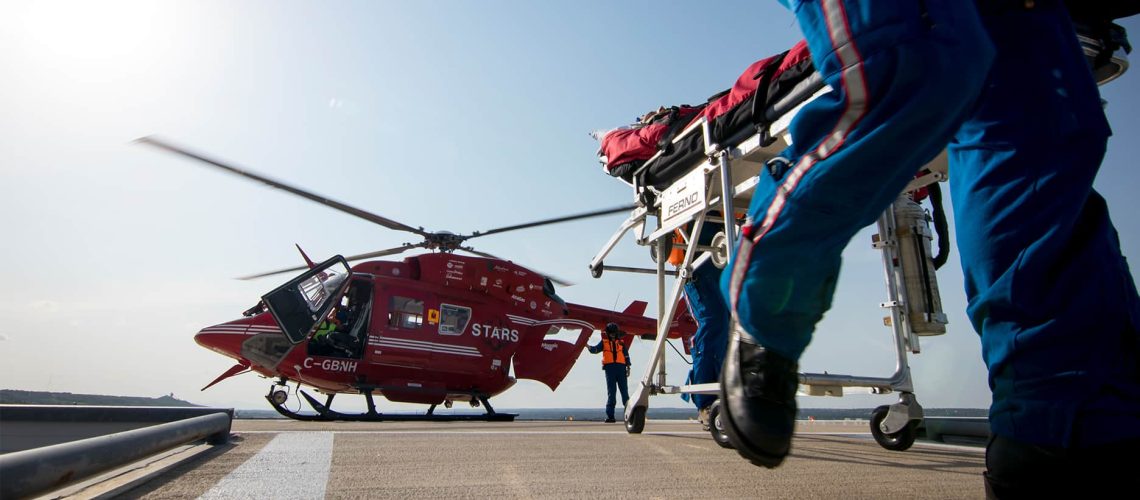Saving More Lives in the Sky
By Henry Canaday, Inflight Magazine. Read the article on page 26 in Inflight Magazine’s January-February 2022 issue.
Seventy years ago, during the Korean War, helicopters such as the Sikorsky H-5, Bell H-13 and Hiller H-23 cut fatality rates significantly by carrying wounded soldiers on litter pods to field hospitals. Since that wartime start, air
ambulances have increased dramatically in numbers, capabilities and importance. Indeed, rotor-wing and fixed-wing air ambulances provided US$5.3 billion worth of global services to civilians during 2020, according to Grand View Research.
Much more growth is likely ahead, and even more life-saving innovations are on the horizon. According to Lenny Weiss, Associate Medical Director of STAT MedEvac, further improvements in best-practice emergency rooms might add only a percent or two to survival rates because emergency facilities in advanced countries have been so well studied. But emergency services in the field, such as air ambulances, because these have been less studied and enhanced, have a chance to add 10% to survival rates.
Weiss’s STAT MedEvac and another air ambulance provider, Canada’s STARS, have been testing one hopeful path to helping patients survive: streaming vital sign data continuously to the doctors specializing in emergency care on the ground.
Streaming is enabled by SKYTRAC, which provides data solutions for fixed-wing, rotorwing and unmanned aircraft. Last summer, STARS tested the transmission of patient medical data such as oxygen and carbon dioxide saturation, pulse rate and blood pressure to the ground from an Airbus H145-D3 using SKYTRAC equipment.
STARS in Their Skies
According to SKYTRAC’s Regional Business Manager, Mandi Skinner, STARS did three major tests on several flights between June and August 2021. She says the unique the challenge in connecting rotorcraft is dealing with their lower altitudes and ensuring that no lags or gaps occur in transmission as connections hop from cell tower to cell tower.
Flight paths for helicopters are different from those of fixed-wing air ambulances. “They hover in and out of urban areas, remote areas and mountains,” Skinner explains. “Helicopters are used in very remote areas.” Keeping stable connections can be a challenge, but SKYTRAC enables strong enough signals to keep sending the data.
SKYTRAC can transmit medical data over satellite or cellular networks in the air or through Wi-Fi connections. For economy, cellular is used at lower altitudes when towers are available and Satcom when this is not possible. Automated post-flight downloading of large data files is conducted through Wi-Fi on landing.
Without these capabilities, air ambulances have relied on brief voice messages in-flight and manual data downloads post-flight, which can lead to errors.
Aircraft must be equipped with medical devices to collect data. SKYTRAC’s ISAT-200A satellite communication terminal, which operates on the global Iridium network, and the company’s DAL-200, a smart router enabling cellular and Wi-Fi connections, get data to the ground.
This equipage can serve the same purposes on any rotor- or fixed-wing aircraft, and SKYTRAC has had discussions with many fixed-wing operators. SKYTRAC can connect any aircraft at any point on the globe, ensuring operators make the best connections.
Prescriptive Services
On-ground doctors, called transport physicians, view vital sign data on a web-based portal, so they need only a PC and internet connection. Using cellular or low latency Iridium Low Earth Orbit (LEO) satellites, SKYTRAC delivers common medical data in real-time. For example, if air ambulance staff seek to transmit a 12-lead electrocardiogram (ECG) graph, delivery takes 2-3 minutes.
Skinner hopes to test the transmission of ultrasound images soon. Operators can upgrade to a mid-band DLS-100 transceiver enabling 22 kilobits per second transmission and 88 kbps reception to transmit images. For video transmission, SKYTRAC offers the SDL-350 transceiver and server. SKYTRAC and Iridium’s network keeps all medical data private, as generally required by law.
STARS is a charitable emergency service that specialises in critical care, explains Chief Clinical Officer Cindy Seidl. Funded by the governments of several Canadian provinces and by corporate and community donations, the service aims to be a clinical innovator. STARS is building a new fleet of 10 H145s, one for each of its six bases and four for training or maintenance needs.
“Helicopters are faster than ground for some densely populated urban areas,” Seidl explains. “And they provide access to our provinces, where there is hunting and fishing in the remote bush.” STARS has been serving Alberta, Saskatchewan and Manitoba, since 1985.
The service now does about 3,000 rotorcraft flights a year, each with two pilots, plus a critical care nurse and paramedic. It offers the option of having the transport physician fly onboard with the patient. But for most flights, the transport physician is on the ground, at home, or in a dispatch center. Seidl says that streaming vital signs to this doctor increases their “virtual presence”.
“The transport physician can log in to see the cardiac monitor and help manage the patient remotely,” the clinician says. “If the patient is having a heart attack, they can have a team available.” Real-time data on heart rates, ECGs, blood pressure, oxygen, and carbon dioxide saturation help the doctor to advise onboard staff on managing heart, stroke, and other critical conditions with the right medicine or treatment.
In the past, nurses or paramedics could patch into the helicopter’s radio and tell the transport physician about blood pressure or other critical data. “Now, the doctor can see what’s happening in real-time and manage quicker,” Seidl says.
STARS chose SKYTRAC for real-time connectivity partly because it has partnered with SKYTRAC for many years. “They are easy to work with and very innovative,” Seidl observes. SKYTRAC equipment is linked with the latest version of Zoll cardiac monitors,
which provide the data. “We now have new cardiac monitors, a new fleet and new connections.”
Team Efforts
Ultrasound images taken onboard are now stored on and transferred by a memory stick. Once all the current transmission capabilities have been proved, new aircraft equipped and operating methods set, STARS may also transmit these in-flight. And the final result? “It’s hard to measure at this point,” Seidl admits. “But we are very confident it will have a real impact on patient outcomes.”
STAT MedEvac successfully ground-tested the SKYTRAC system in early 2020 to transmit medical data securely from a Zoll monitor. Part of the international UPMC Health System, STAT MedEvac serves five US states – New York, Pennsylvania, Ohio, West Virginia and Maryland – from 18 base stations.
STAT MedEvac transports patients with 23 Airbus H135s, EC135s and EC145s, each with a single pilot and several ground ambulances. Usually 18 helicopters are in service, with five for training, maintenance and operational support. The choppers typically fly about 11,000 flights per year.
STAT MedEvac’s interest in real-time data transfer reflects several factors. “We are in a world of rapidly evolving availability and use of technology,” observes Doctor Weiss. “Health intervention is a race against the clock. Therefore, getting important information to the right stakeholder accurately and efficiently is paramount to modern healthcare.”
And emergency services generate massive volumes of critical data, from biometric monitors to ventilators and intravenous infusion pumps. All this data is essential to keeping patients safe in-flight and saving lives. To transmit data, STAT MedEvac has been using cell phones on the ground in areas where cell service is available and in-flight radio transmission of some information. But these channels are limited to voice reports of patient status, after which in-flight medical staff await voice instructions. In addition, airborne staff have very limited access to satellite links. “It’s bandwidth limited and very expensive,” Weiss explains.
STAT MedEvac does use video-based consultation with physicians, but this capability is possible only within ground buildings with Wi-Fi services. Many airborne patients come with packages of up to 200 pages of medical information, which the crew must read through to understand. And plenty of in-flight monitoring files must be downloaded on landing. Aircrew also record visual data on intubations for education and quality improvement.
STAT MedEvac rotorcraft have Zoll cardiac monitors, ECG devices, pulse oximeters, and other equipment. One in five patients are on ventilators, and when problems arise with these devices, troubleshooting must be done orally over the radio. The next software update from SKYTRAC will enable real-time troubleshooting with data.
Even with very limited in-flight connections, STAT MedEvac engages ground physicians on about two-thirds of its flights. President James Houser estimates that most air ambulance services do so only 5-15% of the time.
STAT MedEvac’s Medical Director Frank Guyette says most air ambulances rely on lengthy written protocols, giving step-by-step
guidance on what to do under each set of conditions. “Our philosophy is we try as a team to get physicians involved as much as
possible.”
At the same time, it is essential that any communication tool be practical, available and reliable. And if the tool is not easy to use, it could distract from paying attention to the patient, thus degrading care. For example, if video conferencing takes too much time to set up, that would be another reason to forgo video capability in addition to limited bandwidth.
Push To Talk
Weiss would like the kind of connectivity one Mississippi hospital has with its satellite emergency facilities. “I would like to be able to push a button and have connectivity and all the data communicated.”
But Weiss was impressed with the SKYTRAC test and the possibilities it opens up. “I was pleased. This is only the tip of the iceberg, and more tests need to happen.” He says SKYTRAC is the only company now offering these possibilities.
If the SKYTRAC system proves as effective as STARS and STAT MedEvac hope, there should be plenty more opportunities for installation. For example, Air Methods operates more than 300 air medical bases across the US. It is currently upgrading its fleet to Wi-Fi connections, but that work is not complete. Air Methods aircraft now use satellite and radio systems to relay only “pertinent information,” according to Communications VP Doug Flanders.
In the US alone, more than a half-million patients use air ambulances each year. But the US is exceptional in population size, dispersion of population and health expenditures. While the US probably has nearly a thousand rotor- and fixed-wing air ambulances, the smaller, less densely populated UK has less than 50.
But Europe as a whole has nearly a fifth of the air ambulance market, or current revenue of about $1 billion a year. And the consultancy Marketwatch estimates that global air ambulance revenue will grow to more than $11 billion by 2024. Consultants at Grand View Research are even more bullish. They estimate revenue will grow 10% annually from 2021 to 2028.
At least 75% of that revenue and a much higher portion of flights are operated by rotorcraft, which generally do the shorter trips. Fixed-wing aircraft, plus ground ambulances, handle the long flights when patients need to seek speciality care at distant facilities or simply be brought home to hospitals near family and friends.
Any really effective connectivity solution has to handle both helicopters and jets, anyplace in the world and as easily and seamlessly as possible. That is the kind of system SKYTRAC, STARS and STAT MedEvac have been working on.
Get in Touch
Speak with a connectivity expert today. We are eager to discuss your business needs.

